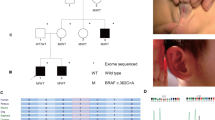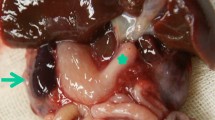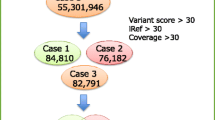Abstract
Anorectal malformations (ARM) are rare congenital malformations of the gastrointestinal tract. Approximately 60 % of the patients have additional congenital malformations, such as hypospadias. A recently published article showed that deletion of one single gene, dickkopf WNT signaling pathway inhibitor-1 (Dkk1), resulted in an imperforate anus with rectourinary fistula and preputial hypospadias in mice. To determine whether DKK1 also plays a role in the etiology of ARM and hypospadias in humans, we sequenced the four exons of the DKK1 gene in 17 patients affected with both ARM and hypospadias. No new potential disease-causing variant was identified. However, we detected a known non-synonymous variant in one patient, which was predicted in silico to be damaging, and the corresponding unaffected amino acid is highly conserved.
Conclusion: In this human study, a potential interesting non-synonymous variant was found in the DKK1 gene. Whether this variant plays a contributory role in the genesis of ARM or hypospadias would require a much larger study.
Similar content being viewed by others
Abbreviations
- ARM:
-
Anorectal malformations
- PCR:
-
Polymerase chain reaction
- UTR:
-
Untranslated region
References
Adzhubei IA, Schmidt S, Peshkin L, Ramensky VE, Gerasimova A, Bork P, Kondrashov AS, Sunyaev SR (2010) A method and server for predicting damaging missense mutations. Nat Methods 7:248–249. doi:10.1038/nmeth0410-248
Beleza-Meireles A, Lundberg F, Lagerstedt K, Zhou X, Omrani D, Frisen L, Nordenskjold A (2007) FGFR2, FGF8, FGF10 and BMP7 as candidate genes for hypospadias. Eur J Hum Genet 15:405–410
Bell J (2008) A simple way to treat PCR products prior to sequencing using ExoSAP-IT. Biotechniques 44:834. doi:10.2144/000112890
Boomsma DI, Wijmenga C, Slagboom EP, Swertz MA, Karssen LC, Abdellaoui A, Ye K, Guryev V, Vermaat M, van Dijk F, Francioli LC, Hottenga JJ, Laros JF, Li Q, Li Y, Cao H, Chen R, Du Y, Li N, Cao S, van Setten J, Menelaou A, Pulit SL, Hehir-Kwa JY, Beekman M, Elbers CC, Byelas H, de Craen AJ, Deelen P, Dijkstra M, den Dunnen JT, de Knijff P, Houwing-Duistermaat J, Koval V, Estrada K, Hofman A, Kanterakis A, Dv E, Mai H, Kattenberg M, van Leeuwen EM, Neerincx PB, Oostra B, Rivadeneira F, Suchiman EH, Uitterlinden AG, Willemsen G, Wolffenbuttel BH, Wang J, de Bakker PI, van Ommen GJ, van Duijn CM (2014) The Genome of the Netherlands: design, and project goals. Eur J Hum Genet 22:221–227. doi:10.1038/ejhg.2013.118
Calabrese R, Capriotti E, Fariselli P, Martelli PL, Casadio R (2009) Functional annotations improve the predictive score of human disease-related mutations in proteins. Hum Mutat 30:1237–1244. doi:10.1002/humu.21047
Chen T, Li Q, Xu J, Ding K, Wang Y, Wang W, Li S, Shen Y (2007) Mutation screening of BMP4, BMP7, HOXA4 and HOXB6 genes in Chinese patients with hypospadias. Eur J Hum Genet 15:23–28
Cuschieri A, Group EW (2002) Anorectal anomalies associated with or as part of other anomalies. Am J Med Genet 110:122–130
Grantham R (1974) Amino acid difference formula to help explain protein evolution. Science 185:862–864
Guo C, Sun Y, Guo C, MacDonald BT, Borer JG, Li X (2014) Dkk1 in the peri-cloaca mesenchyme regulates formation of anorectal and genitourinary tracts. Dev Biol 385:41–51
Hagan DM, Ross AJ, Strachan T, Lynch SA, Ruiz-Perez V, Wang YM, Scambler P, Custard E, Reardon W, Hassan S, Nixon P, Papapetrou C, Winter RM, Edwards Y, Morrison K, Barrow M, Cordier-Alex MP, Correia P, Galvin-Parton PA, Gaskill S, Gaskin KJ, Garcia-Minaur S, Gereige R, Hayward R, Homfray T (2000) Mutation analysis and embryonic expression of the HLXB9 Currarino syndrome gene. Am J Hum Genet 66:1504–1515
Holschneider A, Hutson J, Peña A, Beket E, Chatterjee S, Coran A, Davies M, Georgeson K, Grosfeld J, Gupta D, Iwai N, Kluth D, Martucciello G, Moore S, Rintala R, Smith ED, Sripathi DV, Stephens D, Sen S, Ure B, Grasshoff S, Boemers T, Murphy F, Söylet Y, Dübbers M, Kunst M (2005) Preliminary report on the International Conference for the Development of Standards for the Treatment of Anorectal Malformations. J Pediatr Surg 40:1521–1526
International Clearinghouse (2012) Annual report 2012—International clearinghouse for birth defects surveillance and research. Available at: http://www.icbdsr.org/filebank/documents/ar2005/Report2012.pdf. Accesssed May 25, 2013.
Kang S, Graham JM Jr, Olney AH, Biesecker LG (1997) GLI3 frameshift mutations cause autosomal dominant Pallister-Hall syndrome. Nat Genet 15:266–268
Kohlhase J, Wischermann A, Reichenbach H, Froster U, Engel W (1998) Mutations in the SALL1 putative transcription factor gene cause Townes-Brocks syndrome. Nat Genet 18:81–83
Kurahashi N, Murakumo M, Kakizaki H, Nonomura K, Koyanagi T, Kasai S, Sata F, Kishi R (2004) The estimated prevalence of hypospadias in Hokkaido, Japan. J Epidemiol 14:73–77
Li B, Krishnan VG, Mort ME, Xin F, Kamati KK, Cooper DN, Mooney SD, Radivojac P (2009) Automated inference of molecular mechanisms of disease from amino acid substitutions. Bioinformatics 25:2744–2750. doi:10.1093/bioinformatics/btp528
Lin C, Yin Y, Veith GM, Fisher AV, Long F, Ma L (2009) Temporal and spatial dissection of Shh signaling in genital tubercle development. Development 136:3959–3967. doi:10.1242/dev.039768
Misra D, Mushtaq I, Drake DP, Kiely EM, Spitz L (1996) Associated urologic anomalies in low imperforate anus are capable of causing significant morbidity: a 15-year experience. Urology 48:281–283
Miyagawa S, Moon A, Haraguchi R, Inoue C, Harada M, Nakahara C, Suzuki K, Matsumaru D, Kaneko T, Matsuo I, Yang L, Taketo MM, Iguchi T, Evans SM, Yamada G (2009) Dosage-dependent hedgehog signals integrated with Wnt/beta-catenin signaling regulate external genitalia formation as an appendicular program. Development 136:3969–3978. doi:10.1242/dev.039438
Narumi Y, Kosho T, Tsuruta G, Shiohara M, Shimazaki E, Mori T, Shimizu A, Igawa Y, Nishizawa S, Takagi K, Kawamura R, Wakui K, Fukushima Y (2010) Genital abnormalities in Pallister-Hall syndrome: report of two patients and review of the literature. Am J Med Genet A 152A:3143–3147. doi:10.1002/ajmg.a.33720
Nassar N, Bower C, Barker A (2007) Increasing prevalence of hypospadias in Western Australia, 1980–2000. Arch Dis Child 92:580–584
Ross AJ, Ruiz-Perez V, Wang Y, Hagan DM, Scherer S, Lynch SA, Lindsay S, Custard E, Belloni E, Wilson DI, Wadey R, Goodman F, Orstavik KH, Monclair T, Robson S, Reardon W, Burn J, Scambler P, Strachan T (1998) A homeobox gene, HLXB9, is the major locus for dominantly inherited sacral agenesis. Nat Genet 20:358–361
Schwarz JM, Rodelsperger C, Schuelke M, Seelow D (2010) MutationTaster evaluates disease-causing potential of sequence alterations. Nat Methods 7:575–576. doi:10.1038/nmeth0810-575
Sudo Y, Numakura C, Abe A, Aiba S, Matsunaga A, Hayasaka K (2010) Phenotypic variability in a family with Townes-Brocks syndrome. J Hum Genet 55:550–551. doi:10.1038/jhg.2010.64
Wong EH, Cui L, Ng CL, Tang CS, Liu XL, So MT, Yip BH, Cheng G, Zhang R, Tang WK, Yang W, Lau YL, Baum L, Kwan P, Sun LD, Zuo XB, Ren YQ, Yin XY, Miao XP, Liu J, Lui VC, Ngan ES, Yuan ZW, Zhang SW, Xia J, Wang H, Sun XB, Wang R, Chang T, Chan IH, Chung PH, Zhang XJ, Wong KK, Cherny SS, Sham PC, Tam PK, Garcia-Barcelo MM (2013) Genome-wide copy number variation study in anorectal malformations. Hum Mol Genet 22:621–631. doi:10.1093/hmg/dds451
Yucel S, Dravis C, Garcia N, Henkemeyer M, Baker LA (2007) Hypospadias and anorectal malformations mediated by Eph/ephrin signaling. J Pediatr Urol 3:354–363
Zhang J, Zhang ZB, Gao H, Zhang D, Wang WL (2009) Down-regulation of SHH/BMP4 signalling in human anorectal malformations. J Int Med Res 37:1842–1850
Acknowledgments
We thank the surgical and other staff members of the Departments of Surgery-Pediatric surgery and Urology-Pediatric urology, Radboudumc Amalia Children’s Hospital of the Radboud university medical center in Nijmegen, the Department of Pediatric Surgery of the Sophia Children’s Hospital, and the Department of Clinical Genetics of the Erasmus Medical Centre in Rotterdam for their collaboration in collecting data from patients. We also thank the staff members of the Department of Human Genetics from the Radboud university medical center in Nijmegen for their guidance and assistance with Sanger sequencing. Finally, we are grateful to the patients who participated in this study. This study was funded by the Radboud university medical center, Nijmegen, The Netherlands.
Conflict of interest
The authors have no conflict of interest to disclose.
Ethical standards
The AGORA study protocol was approved by the Regional Committee on Research Involving Human Subjects Arnhem-Nijmegen, and written informed consent was obtained from all participants and/or their parents.
Author information
Authors and Affiliations
Corresponding author
Additional information
Communicated by Beat Steinmann
Rights and permissions
About this article
Cite this article
van de Putte, R., Wijers, C.H.W., de Blaauw, I. et al. Sequencing of the DKK1 gene in patients with anorectal malformations and hypospadias. Eur J Pediatr 174, 583–587 (2015). https://doi.org/10.1007/s00431-014-2436-x
Received:
Revised:
Accepted:
Published:
Issue Date:
DOI: https://doi.org/10.1007/s00431-014-2436-x




